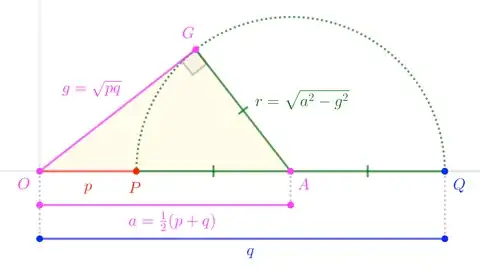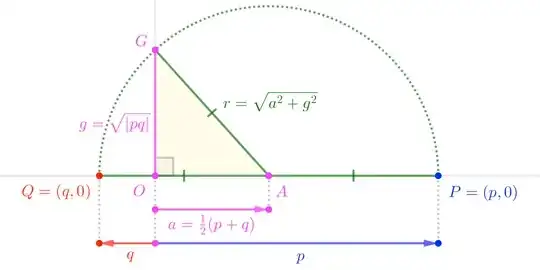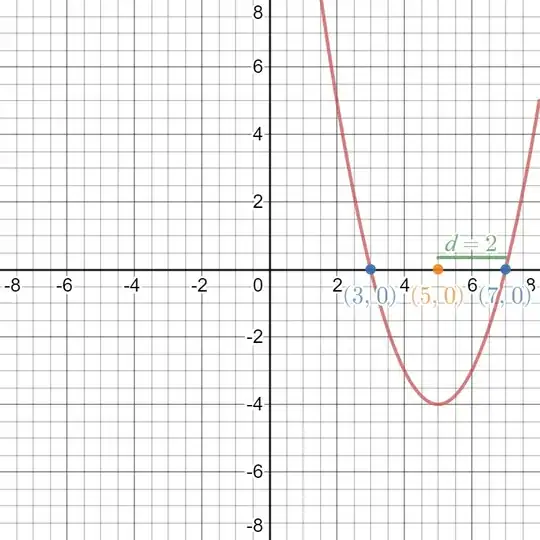Here's a geometric justification of the approach.
Suppose $P:=(p,0)$ and $Q:=(q,0)$ are points on the positive $x$-axis. (See Note for when $p$ and $q$ differ in sign.) Consider a (semi-)circle with diameter $\overline{PQ}$.

If $A$ is the center of that circle, then
$$a := |OA| = \frac12\left(|OP|+|OQ|\right) = \frac12(p+q) \tag1$$
If $G$ is the point where the tangent from $O$ meets the circle, then (by the Power of a Point theorems),
$$|OG|^2 = |OP||OQ| \quad\to\quad g := |OG| = \sqrt{pq} \tag2$$
(Thus, $a$ is the arithmetic mean of $p$ and $q$, while $g$ is the geometric mean, which may explain my choice of variable names.) If $r$ is the radius of the circle, then we clearly have that $P$ and $Q$ are at distance $r$ from $A$, so that (abusing notation slightly)
$$\{p,q\} \;=\; a \pm r \tag3$$
But $\triangle OAG$ has a right angle at $G$, so that Pythagoras tells us $a^2 = g^2 + r^2$. Solving for $r$, we can write
$$\{p,q\} \;=\; a \pm \sqrt{a^2-g^2} \tag{$\star$}$$
That is, $(\star)$ tells us how to calculate two numbers ($p$ and $q$) from their means ($a$ and $g$). Nifty.
Now, the relevance to the Quadratic Formula comes from supposing that the monic quadratic polynomial $x^2+Bx+C$ has those numbers $p$ and $q$ as roots. We "know" that this means the polynomial must factor as
$$x^2 + Bx + C = (x-p)(x-q) = x^2-(p+q)x + pq \tag4$$
Comparing coefficients, we have
$$B = -(p+q) \qquad\qquad C = pq \tag5$$
This shows that $B$ is the negative of the sum of the roots, and $C$ is the product. (Vieta's formulas generalize this observation to general polynomials.) In the context of our geometric argument, $B$ is the negative of twice the arithmetic mean, and $C$ is the square of the geometric mean.
$$B = -2a \qquad\qquad C = g^2 \tag6$$
Substituting $a=-B/2$ and $g^2=C$ into $(\star)$ gives Loh's preferred form of the (monic) Quadratic Formula:
$$\{p,q\}\;=\;-\frac{B}2\pm\sqrt{\left(\frac{B}2\right)^2-C} \tag{$\star\star$}$$
I may myself prefer to think of this as "$(\star)$ + Vieta".
Note: Adjusting the argument for $P$ and $Q$ on opposite sides of $O$ (corresponding to quadratic roots differing in sign) gets a little fiddly depending upon how we introduce negatives into the geometry. Here, we'll consider $p$, $q$, and $a$ to be signed distances; this allows us to maintain the relation $a=\tfrac12(p+q)$. The figure for this case takes $G$ to be the point where the perpendicular at $O$ meets the circle; its (unsigned) length is the geometric mean of unsigned lengths $|OP|$ and $|OQ|$, so we write $g = \sqrt{|pq|}$.

Again, $\triangle OAG$ is a right triangle, but $r$ is now the hypotenuse, giving the counterpart of $(\star)$ this form:
$$\{p,q\} \;=\; a \pm\sqrt{a^2+g^2} \tag{$\star'$}$$
Taking $p$ and $q$ to be roots of $x^2+Bx+C$ as before, we still have relations $(5)$, because the signs of the roots don't affect the algebra leading to those relations. However, the signs do require us to write $g^2= -C$ (because $g^2=|pq|^2$ is positive, while $C=pq$ is negative). But this weirdness exactly cancels the Pythagorean sign change in $(\star')$, so that substitution gives us $(\star\star)$ again. Convenient, that.
Final tweaks to show that $(\star\star)$ also holds for $p$ and $q$ both negative, or when one or both vanish, are left as exercises to the reader.


